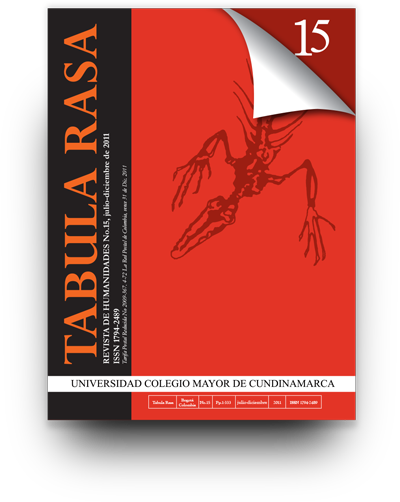The New Right of Cultural Studies —Creative Industries
La nueva derecha de los estudios culturales – Las industrias creativas –
Show authors biography
Creative-industries discourse represents the most interesting and productive response to a crisis of relevance for the humanities and the emergence of a knowledge society. Its impact has been felt across the world, not least in the hitherto-progressive field of cultural studies, where we see a New Right emerging as part of the push to renovate the university.
Article visits 119 | PDF visits 121
Downloads
Attali, Jacques. 2008. “This is not America’s Final Crisis.” New Perspectives Quarterly. 25 (2): 31-33.
Australian Academy of the Humanities. 2010. Submission in Response to Research Workforce Strategy. Documento de consulta: Meeting Australia’s Research Workforce Needs. Retrieved from <http://www.innovation.gov.au/Research/Documents/Submission75.pdf>.
Bakhshi, Hasan; Philippe Schneider y Christophe Walker. 2008. Arts and Humanities Research and Innovation. Londres, Arts & Humanities Research Council/National Endowment for Science; Technology & the Arts.
Bar, François y Caroline Simard. 2006. “From Hierarchies to Network Firms.” The Handbook of New Media: Updated Students Edition. Leah Lievrouw y Sonia Livingstone (eds.) Thousand Oaks: Sage. 350-363.
Bell, Daniel. 1977. “The Future World Disorder: The Structural Context of Crises.” Foreign Policy. 27: 109-135.
Brint, Steven G., Lori Turk-Bicakci, Kristopher Proctor y Scott Patrick Murphy. 2009. “Expanding the Social Frame of Knowledge: Interdisciplinary, Degree-Granting Fields in
American Colleges and Universities, 1975-2000”. Review of Higher Education. 32 (2): 155-83. British Academy. 2004. ‘That Full Complement of Riches’: The Contributions of the Arts, Humanities and Social Sciences to the Nation’s Wealth. Retrieved from <http://www.britac. ac.uk/policy/full-complement-riches.cfm>.
Brzezinski, Zbigniew. 1969. Between Two Ages: America’s Role in the Technotronic Era. Nueva York, Viking Press.
Attali, Jacques. 2008. “This is not America’s Final Crisis.” New Perspectives Quarterly. 25 (2): 31-33.
CHASS. 2006. CHASS Submission: Productivity Commission Study on Science and Innovation. Retrieved from <http://www.chass.org.au/submissions/pdf/SUB20060807TG.pdf>.
Cohen, Patricia. 2010, November 16. “Digital Keys for Unlocking the Humanitie Riches”. New York Times. Retrieved from <http://www.nytimes.com/2010/11/17/
arts/17digital.html>.
Cunningham, Stuart. 1992. Framing Culture: Criticism and Policy in Australia. Sidney, Allen and Unwin.
Cunningham, Stuart. 2006a, September 18. “Don’t Undervalue Humanities.” Australian Financial Review. 42.
Cunningham, Stuart. 2006b, August 14. “Business Needs Crash Course in Appreciation”. Australian Financial Review. 36.
Cunningham, Stuart. 2007a. “Oh, the Humanities! Australia’s Innovation System out of Kilter.” Australian Universities Review. 49 nos. 1-2: 28-30.
Cunningham, Stuart. 2007b, 22 de junio. “Taking Arts into the Digital Era.” Courier Mai. Retrieved from <http://www.onlineopinion.com.au/view.asp?article=6031>.
Cunningham, Stuart. 2009a, 7 de diciembre. “Can Creativity be Taught? And Should it Be?” AustralianPolicyOnline. Retrieved from <http://www.apo.org.au/commentary/cancreativity-be-taught-and-should-it-be>.
Cunningham, Stuart. 2009b. “Creative Industries as a Globally Contestable Policy Field.” Chinese Journal of Communication. 2 (1): 13-24.
Cunningham, Stuart. 2009c. “Trojan Horse or Rorschach Blot? Creative Industries Discourse Around the World.” International Journal of Cultural Policy. 15 (4): 375-86.
Dahlström, Margareta y Brita Hermelin. 2007. “Creative Industries, Spatiality and Flexibility: The Example of Film Production.” Norsk Geografisk Tiddskrift—Norwegian Journal of Geography. 61 (3): 111-21.
Davidson, Cathy N. 2008. “Humanities 2.0: Promise, Perils, Predictions.” PMLA. 123 (3): 707-17.
Edgar, David. 2000. “Playing Shops, Shopping Plays: The Effect of the Internal Market on Television Drama.” British Television Drama: Past, Present and Future. Jonathan Bignell, Stephen Lacey y Madeleine Macmurraugh-Kavanagh (eds). Houndmills: Palgrave Macmillan. 73-77.
Emerson, Ralph Waldo. 1909-14. Essays and English Traits. Cambridge, Mass., Harvard Classics.
Florida, Richard. 2002. The Rise of the Creative Class and How it’s Transforming Work, Leisure and Everyday Life. Nueva York, Basic Books.
García Canclini, Néstor. 2004. Diferentes, desiguales y desconectados: Mapas de la interculturalidad. Barcelona, Gedisa.
Garnham, Nicholas. 2005. “From Cultural to Creative Industries: An Analysis of the Implications of the ‘Creative Industries’ Approach to Arts and Media Policy Making in the United Kingdom.” International Journal of Cultural Policy. 11 (1): 15-29.




